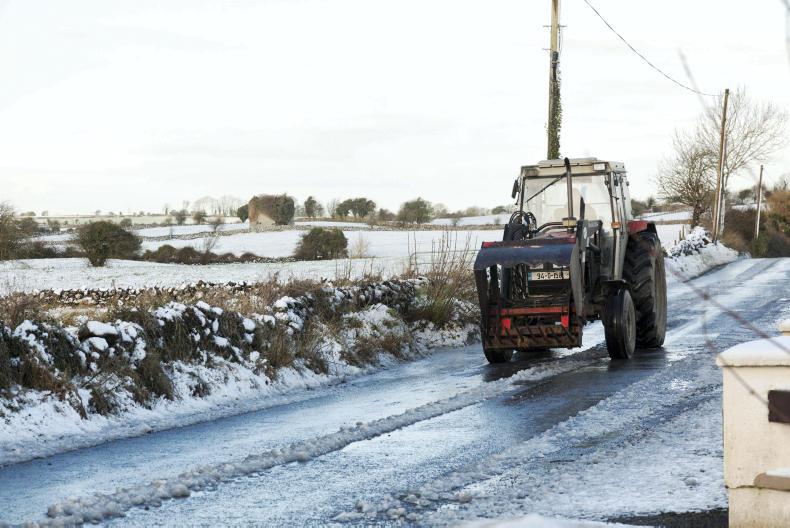Make sure any engine-powered equipment around your yard has anti-freeze in the radiator. This has a lower freezing point than water so it protects the radiator from freezing solid. This may also include the loader and diesel generator for the milking parlour. Check your jump leads and make sure they are in a place you can find them such as behind the driver’s seat. Remember, when a battery in a tractor is dead, attach the leads to the terminals of this tractor first before attaching to the “boosting” tractor. Always attach the earth or negative lead first and the live or positive lead last. If a battery looks damaged, handle with extreme care as the acid can cause serious damage to both man and machine.

Where possible, park tractors and loaders inside to avoid the worst of the cold weather.Where possible, park the tractor in a shed during the severe cold. If there is room, park it on the passage where cattle are housed as their body heat will raise the ambient temperature around the tractor slightly.
Drain any excess water from the diesel separator bowl underneath the fuel filter and make sure the diesel you are using is suitable for use in winter weather. Check with your supplier. Also, look into the diesel storage tank and central heating tank to make you have enough in reserve to get you through the cold weather.

If driving on ice or snow covered roads, allow extra braking distance. If a front loader is fitted, keep it as low as possible the ground in case you need to stop suddenly. If driving on ice or snow covered roads, allow extra braking distance. If a front loader is fitted, keep it as low as possible the ground in case you need to stop suddenly.
When starting the tractor, give it a chance to warm up and don’t rev the engine for at least five minutes. Oil becomes viscous in cold weather and doesn’t flow as well as when it is warm.
If you have a slurry tanker or sprayer, where possible drain any excess water from the pumps. When this has been done, cover the pumps as much as possible to prevent any remaining water freezing causing irreparable damage.
If you do use water ballast in tyres, these should be parked in a shed away from the severity of the frost to prevent damage from the big freeze. If necessary, drain the wheels completely.
Another smaller piece of equipment that should be drained of all water is the power washer.
Make sure any engine-powered equipment around your yard has anti-freeze in the radiator. This has a lower freezing point than water so it protects the radiator from freezing solid. This may also include the loader and diesel generator for the milking parlour. Check your jump leads and make sure they are in a place you can find them such as behind the driver’s seat. Remember, when a battery in a tractor is dead, attach the leads to the terminals of this tractor first before attaching to the “boosting” tractor. Always attach the earth or negative lead first and the live or positive lead last. If a battery looks damaged, handle with extreme care as the acid can cause serious damage to both man and machine.

Where possible, park tractors and loaders inside to avoid the worst of the cold weather.Where possible, park the tractor in a shed during the severe cold. If there is room, park it on the passage where cattle are housed as their body heat will raise the ambient temperature around the tractor slightly.
Drain any excess water from the diesel separator bowl underneath the fuel filter and make sure the diesel you are using is suitable for use in winter weather. Check with your supplier. Also, look into the diesel storage tank and central heating tank to make you have enough in reserve to get you through the cold weather.

If driving on ice or snow covered roads, allow extra braking distance. If a front loader is fitted, keep it as low as possible the ground in case you need to stop suddenly. If driving on ice or snow covered roads, allow extra braking distance. If a front loader is fitted, keep it as low as possible the ground in case you need to stop suddenly.
When starting the tractor, give it a chance to warm up and don’t rev the engine for at least five minutes. Oil becomes viscous in cold weather and doesn’t flow as well as when it is warm.
If you have a slurry tanker or sprayer, where possible drain any excess water from the pumps. When this has been done, cover the pumps as much as possible to prevent any remaining water freezing causing irreparable damage.
If you do use water ballast in tyres, these should be parked in a shed away from the severity of the frost to prevent damage from the big freeze. If necessary, drain the wheels completely.
Another smaller piece of equipment that should be drained of all water is the power washer.








 This is a subscriber-only article
This is a subscriber-only article











SHARING OPTIONS: